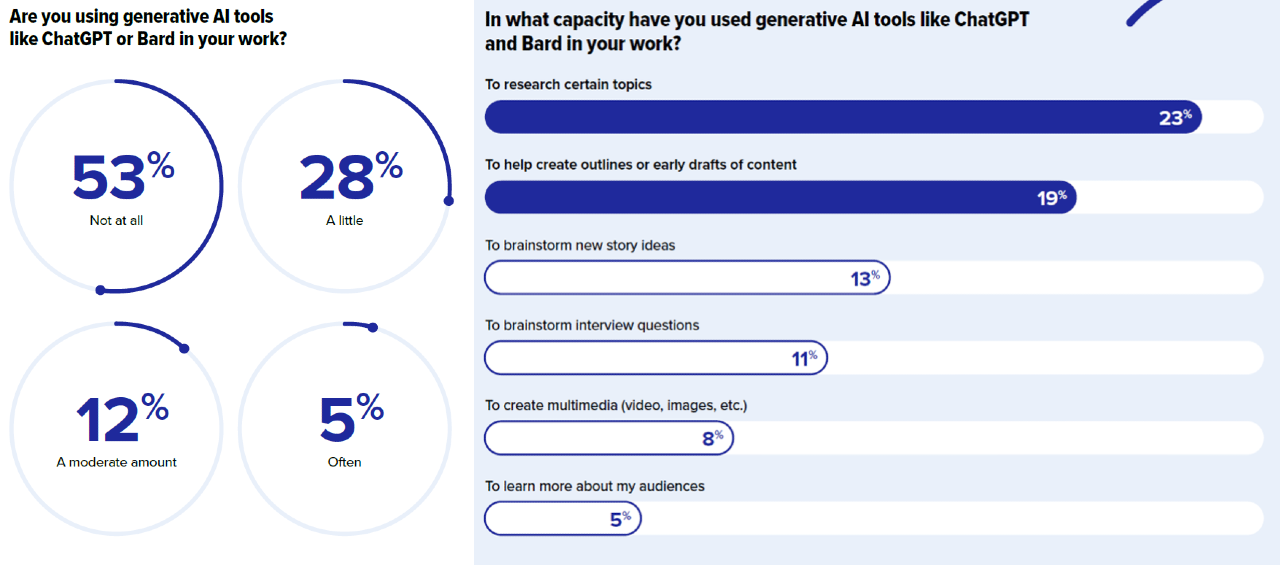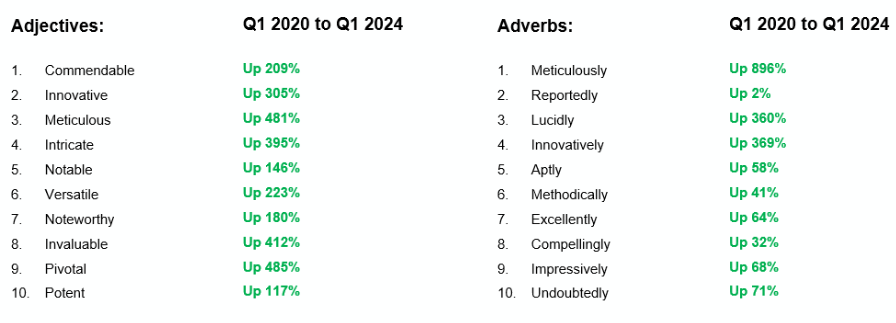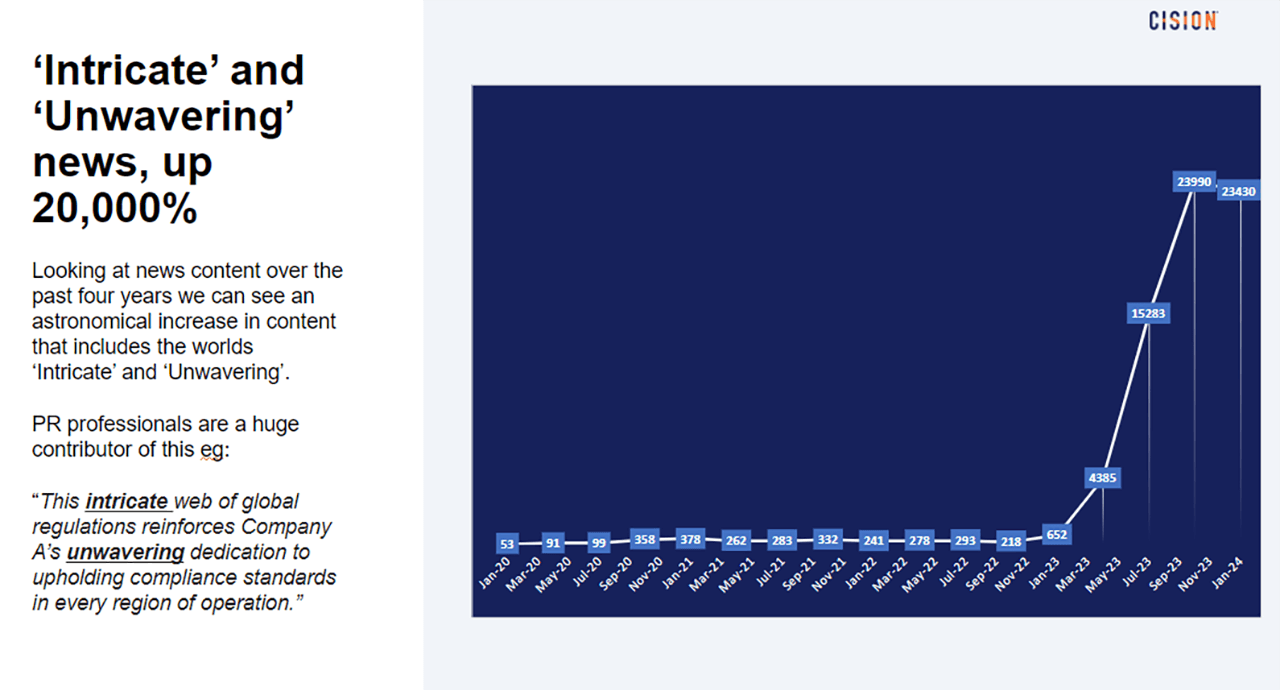Technology’s influence on journalism has been a significant if not always comfortable one. From the typewriter to the printing press, the internet and social media, reporters have always relied on tech innovation to create and share their stories, but the rising prominence of artificial intelligence (AI) has left many questions about how it will impact the profession.
AI has been working away in the background of journalism (and public relations) for some time. A spellcheck in Word? An audio transcription service? Using Grammarly or Hemingway Editor? They’re all powered by AI and have been useful tools for journalists; however, large language models (LLMs) that support generative AI like ChatGPT and Gemini are different. They can create content and copy from scratch, quickly and at scale, and naturally they’re being met with skepticism by editorial teams whose expertise lies in the written word.
How is Generative AI Used in Journalism?
According to the 2024 State of the Media Report, 26% of journalists named the emergence of AI one of the biggest challenges the industry has faced in the last year. However, nearly half revealed they are leveraging generative AI in various ways for their work – 23% are using it for research, while 19% utilize it to help create outlines or early drafts of content.

Speaking at Cision’s recent Navigating the Media Landscape event, Georgina Lee, News Editor for Channel 4 News’s FactCheck in London, said that while she doesn’t use generative tools like ChatGPT in her work, she has utilized AI-powered transcription platforms in the past.
“[AI] will create a rough transcript draft that I can use as a reference point, but I will obviously be going back and listening to the audio to check. It's very base-level functionality rather than anything substantive,” she said of her AI usage.
It’s a similar story for Martyn Brown, Deputy Political Editor for the Daily Express, He revealed that he previously used Otter, but is no longer allowed to for work security reasons. “The only other time I use AI is when we upload stories online,” he said, adding that his outlet’s CMS (content management system) generates words for captions.
What Journalists Really Think About Generative AI
Journalists mainly use AI to help them work more efficiently and in ways not directly visible to audiences. In Cision’s 2024 State of the Media, reporters shared their thoughts on the technology, with opinions ranging from being adamantly against it to experimenting with smaller writing tasks.
“Generative AI tools are banned in our work,” noted one respondent, while another said, “I will not use AI tools in any aspect of my work.” Those more open to AI said they use it to “generate SEO-friendly headlines” and “create article summaries and social media captions.”
Lee added at Cision’s Navigating the Media Landscape event: “If you’re a fact checker, then you have to fact check the AI. I haven’t seen the use case yet. AI isn’t going to get us a story, it’s to help with a story we’re already doing.”
Brown, meanwhile, admitted to being “quite scared by AI. I know it will multiply over the next 10 years and affect us all, but I suppose I don’t trust it.”
Audiences have also voiced reservations about the use of AI by media outlets. Last year, G/O Media, owner of The AV Club and The Onion, faced a social media backlash for using AI to produce articles. One X user described the move as “pure corporate grossness” while another said they were “confused” by the reasoning for publishing “error filled bot-authored [content].”
More recently, Sports Illustrated found itself at the center of a scandal after it was accused of running articles written by AI, including bylines by fake authors with headshots and biographies. Soon after the scandal broke, The Arena Group, publisher of Sports Illustrated, fired the magazine’s CEO.
The public, like journalists, appears to be uncertain about the use of AI when it comes to generating entirely new content without human input.
The Impact of AI on PR and Journalism
Though there is reticence to adopt generative AI in journalism, it’s important to note that its presence is already being felt through the media’s relationship with PR.
“AI has already significantly impacted the language being used in news,” said Barnaby Barron, Head of Insights EMEA at Cision.
Research from the National Sciences Foundation looked at the terms overused by GPT models compared to humans. Barron examined the usage of these terms in news coverage in Q1 of 2020 and Q1 of 2024 – the results below show a stark increase in terms like “pivotal” and “meticulously” across the media in that time.

Barron also looked at news content over the last four years and found a huge increase in the number of news media articles using the terms “intricate” or “unwavering.”
The below chart shows the number of articles start to increase in January 2023, two months after OpenAI launched ChatGPT to the public, before skyrocketing in July 2023.

According to Barron, the reason for this surge may lie in the public relations world adopting AI to generate press releases before sending them out to journalists.
One notable example can be found in a press release containing the following statement:
“This intricate web of global regulations reinforces [our company’s] unwavering dedication to upholding compliance standards in every region of operation.”
When the same press release was fed into an online AI detector, it resulted in 88% of the text being flagged as likely AI-generated.
“Every action that we take, whether that be creating AI content or press releases that are in part created by AI, it’s starting to impact the news content that's out there and the language we use every day,” said Barron.
AI and Media Relations: Key Takeaways for PRs
There’s no doubt that AI offers many opportunities for PR and communications teams. The technology has been baked into the industry for some time through sentiment analysis, and its ability to automate routine tasks offers the chance to work more efficiently and free up time for creative, human-led work.
However, PR professionals need to think carefully about how they use generative AI, both in anything they create that’s public-facing and in how they communicate with journalists. Here are some key takeaways for comms pros to keep in mind...
- Use AI responsibly. As outlined by Barron, LLMs are already affecting our shared language in significant ways. As AI becomes more pervasive, there’s a risk of an AI feedback loop and “model collapse” as AI trains on AI-generated content. Any press release or campaign made public could be used to train AI, so be aware of the language or assets you use.
- Always think about your audience. Start from a place of knowing your audience and ensure that anything you produce will resonate with them. It’s also worth asking: Will my audience accept – or expect – AI-produced content in the environment they find it? ChatGPT may help you generate ideas, but it might not be right to turn those ideas into content for public consumption.
- Be transparent when using AI. Audiences value trust, authenticity, and accountability. Making clear when AI has been used to create content should be front-of-mind for PR and comms professionals. Being open about the processes and tools used and establishing an AI code of ethics is a good first step and shows a commitment to transparency around AI research, development, and usage.
- Use AI carefully in media outreach. While AI can help create media outreach content like a pitch or press release, the technology is far from perfect. For one, AI-generated content can be easy to spot, as Barron’s findings show, and knowing journalists’ resistance to AI, any outreach they see that has been generated by it is unlikely to be well received. Taking time to curate and humanize the AI-generated content is a must. AI has been shown to generate inaccurate, if not completely false, information. So any time you use AI, it is absolutely critical you double-check and validate the output. Bottom line: Even as AI can help with some PR tasks at scale, personalized (humanized), validated, and relevant press outreach remains critical to securing journalists’ attention and trust.
- Take a page out of the media's book: While many journalists are wary of generative AI tech, they are experimenting with a healthy level of skepticism, validating everything first. They know the technology isn't going anywhere and is constantly evolving, but they also know it is still flawed in many ways.
Additional AI Resources for PR and Communications Teams
For more tips and insight on AI in PR and media, consider these related resources:
- How to Start Using AI for PR and Communications Today
- How Prevalent Is Generative AI in PR and Comms?
- The Rise of Generative AI and What It Means for Comms
- AI in PR & Comms: Trends to Look Out for in 2024
- AI in Public Relations: Benefits & Examples
To learn more about how Cision can help you navigate the challenges and opportunities of AI, get in touch to speak with an expert today.








